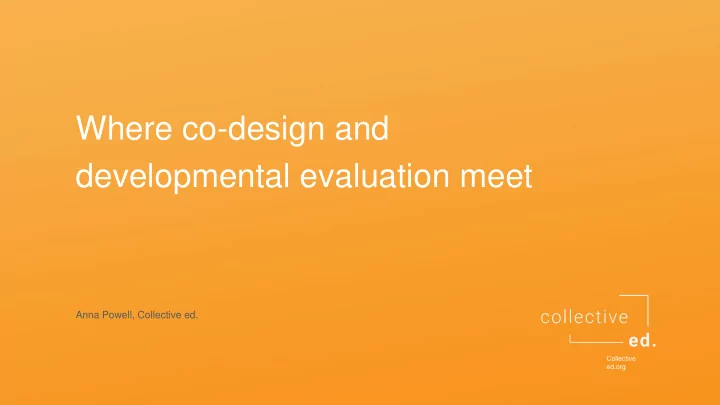

Where co-design and developmental evaluation meet Anna Powell, Collective ed. Collective ed.org
Plan Reality
Currently, 4 in 10 young Tasmanians will not complete year 12.
Currently, 4 in 10 young Tasmanians will not complete year 12. That means that in a year 10 class of 25 students, 10 will not go complete schooling.
Our purpose Our big, bold vision is that all young Tasmanians are thriving. Our 2021 goals are that: • 90% of students in our schools attain year 12; and • they transition into meaningful pathways.
What would it take for all young Tasmanians to thrive?
What would it take for all young Tasmanians to thrive? And what does thriving mean for young Tasmanians?
“Complex environments for social interventions and innovations are those in which what to do to solve problems is uncertain and key stakeholders are in conflict about how to proceed.” Michael Quinn-Patton, 2010
Where does co-design and developmental evaluation meet in Collective ed.?
Guiding questions for the Discovery Phase • What are the hopes, aspirations and challenges of young people in Ulverstone? • What is working well for young people in Ulverstone? • What is helping and hindering young people completing year 12 – and going on to meaningful pathways?
What are the appropriate principles and practices for this context? What What is the most capabilities do we have – and effective model of change for need to build? Collective ed.? Co-design of Ulverstone’s shared agenda for change What is the What conditions readiness for are in place for change – Collective ed. to organizationally, work toward community, systems What outcomes state? change? are we seeing through the co- design process?
What have we learned about Collective ed. and the wider system through this process?
What are the Recruitment appropriate and “The pivot” principles and capability practices for this building context? approach What What is the most capabilities do we have – and effective model of change for need to build? Different Collective ed.? Co-design of levels of Design our Ulverstone’s community way into a shared readiness – movement agenda for need for for change change different models What is the What conditions readiness for are in place for change – Collective ed. to organizationally, work toward 2019 pilot: community, systems initiatives What outcomes Increased state? change? based on co- are we seeing belonging design & DE through the co- and belief practices design process?
What have we learned about doing co-design and developmental evaluation in our context?
What we’re balancing
What we’re balancing • Evaluation for accountability and evaluation for strategic learning • Who’s power and voice in decision making ? • The ‘system’ enabling time for capability building and quality of outcomes • The balcony and the dance-floor • Sandpit or whole playground for early stage, community based discovery
Signs of promise
Signs of promise • Communities starting to drive the initiative • Outcomes for community members through the co-design process itself • Leadership in the communities making this happen • Context specific processes – not a one-size fits all across 6 communities • Umbrella evaluation strategy – bringing it all together
Recommend
More recommend